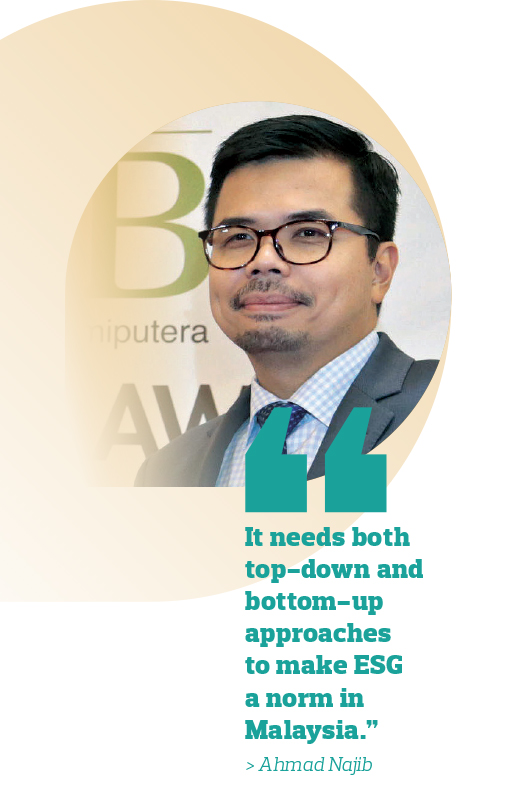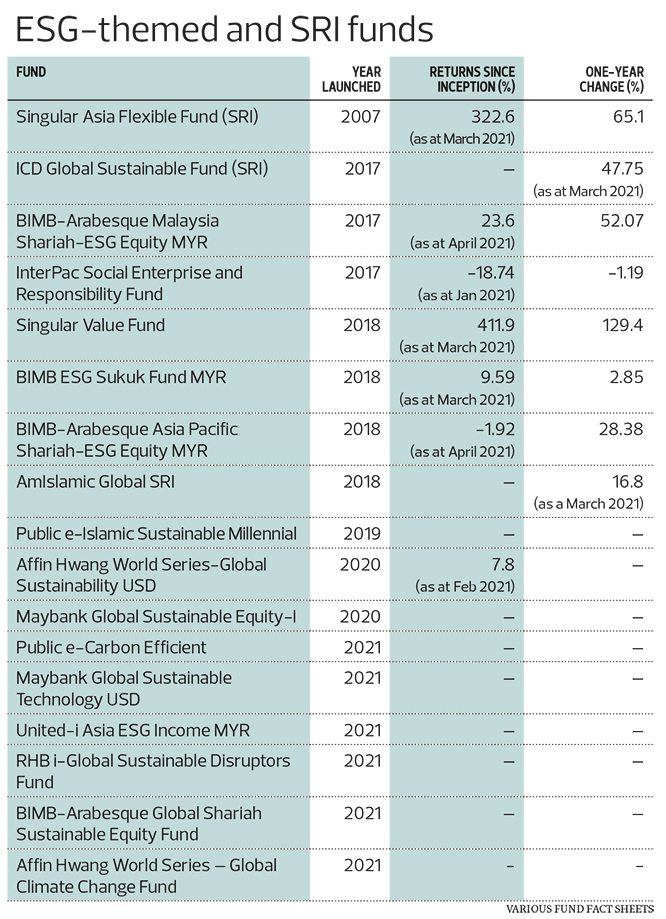
This article first appeared in Wealth, The Edge Malaysia Weekly on May 24, 2021 - May 30, 2021
Since the Covid-19 pandemic broke out, ESG-themed investing has become the flavour of the year.
According to Morningstar, assets under management (AUM) for ESG (environment, social and governance) funds rose 29% globally in 2020, while Lipper data showed that estimated net flows into ESG funds in Asia set a record high (since at least 2006) from the third quarter of 2020.
This interest from investors was also captured by asset managers, who introduced new funds aligned to this trend.
In Malaysia, at least six ESG-themed funds were launched in the first quarter of 2021. Last year, two such funds were added into the mix.
These eight funds join the ranks of nine funds in Malaysia that either state their ESG and sustainability focus in the fund name or are qualified as a Sustainable and Responsible Investment (SRI) fund by the Securities Commission Malaysia (SC).
Yet, despite the popularity of ESG-themed funds in recent times, the development of ESG investments is still considered nascent in Malaysia, say industry players whom Wealth spoke to, citing challenges such as a limited investment universe and lack of quality ESG reporting.
The limitations to growth are reflected in the types of ESG-themed funds available in Malaysia. Of the 17 funds, all but two have either a global or regional focus. The Singular Value Fund invests in Malaysian equities, whereas the BIMB-Arabesque Malaysia Shariah-ESG equity MYR still invests up to 30% of its net asset value in foreign stocks.
Najmuddin Mohd Lutfi, CEO of BIMB Investment Management Bhd, says: “From our experience in launching the fund, only about 80 of the 1,000 stocks available on Bursa Malaysia comply with our ESG requirements, as assessed by Arabesque’s S-ray screening tool. We diversified into foreign stocks to grab the opportunities available in both local and global markets.”
BIMB was one of the early fund houses to launch an ESG-themed fund in Malaysia. Its ESG funds are managed using technology from the UK-based Arabesque Asset Management, which collects more than 250 metrics from reports and news articles to generate an ESG scorecard for companies.
Echoing Najmuddin’s view, Ahmad Najib Nazlan, CEO of Maybank Asset Management Sdn Bhd, says: “The investment universe [locally] is relatively limited compared to the global scheme of things. Therefore, to deliver the most value to our investors, it’s better to construct a portfolio that consists of global securities for diversification to generate higher potential returns and manage downside risks.”
Not easy for fund houses
Why is there a limited investment universe? A major reason is the lack of reliable ESG data from local companies, which David Ng, deputy managing director and chief investment officer of Affin Hwang Asset Management (AHAM), says is “the biggest challenge” the company is facing.
“There has been a dearth of publicly available ESG information locally, along with a lack of corporate commitment to long-term ESG targets. Some developments have been made, but we still have our work cut out for us to bring ESG to the forefront of business and investment management,” Ng says.
The interviewees agree that reporting quality is not even across the board, resulting in data gaps.
“This presents challenges in terms of comparability when we undertake sustainability assessment of stocks for ESG-themed funds,” says Lum Ming Jang, chief investment officer of Public Mutual Bhd.
This means fund houses have to invest extra resources to verify the accuracy of the information reported. Some rely on information from ESG rating agencies, while others such as BIMB use tech-enabled screening tools by third parties.
To be effective, however, the methodologies must be transparent.
“Each ESG data service provider usually uses an opaque proprietary scoring system. As a result, the ESG scores for a specific company can vary across different service providers, making it difficult for a fund manager to assess the scores,” says Ahmad Najib.
ESG factors, which are generally non-financial data, are also not typically endorsed by third parties and the rules of disclosure vary, explains Ismitz Matthew De Alwis, CEO of Kenanga Investors Bhd.
If this is not monitored properly, it could result in cases of greenwashing. Given the rising number of ESG-themed funds, it is important for investors to take note of this point.
“Given the lack of a single ESG reporting standard, ESG offerings in the market may be driven by companies’ ability to hype up ESG initiatives through effective marketing and advertising. That’s why consistent and comparable data is crucial for investors to evaluate a company’s ESG efforts. Bursa Malaysia’s Sustainability Reporting Guide has a list of disclosure considerations, but not all companies appear to disclose the same set of indicators,” says De Alwis.
He is referring to Bursa Malaysia’s requirement for listed companies to include sustainability-related disclosures in their annual reports. These include statements of material ESG risks and opportunities and the governance structure in place to manage it.
Some listed companies have also committed to reporting according to international standards such as those set by the Task Force for Climate-related Disclosures (TCFD).
Despite the challenges, the interviewees acknowledge that it takes time for companies to adapt to these guidelines.
“We believe continued engagement and conversations with corporates can better align the type of ESG data points and depth of disclosure required by investors for their due diligence,” says Ng.
“This is not too dissimilar to the conventional financial metric disclosures that companies have enhanced tremendously over the years, just by listening and adapting to the needs of the investor community.”
A work in progress globally
The difficulty in reporting ESG issues is a problem recognised globally as well. Last September, five of the most significant sustainability standard-setting institutions, including the Global Reporting Initiative and CDP, announced that they would develop a comprehensive solution for corporate reporting.
“If you look at Europe, the policymakers have come up with an EU taxonomy (a classification system for sustainable activities), and a standard method for labelling ESG funds (ecolabel) and disclosure practices. Policymakers in Asia are recognising the need for these standards but they haven’t reached that stage yet,” says Deepak Khurana, director of sustainable finance and Lipper, Asia-Pacific, at Refinitiv.
New Zealand recently required all listed companies, managers of investment schemes, banks and insurers over a certain size to adopt the TCFD standards, which Deepak highlights as a good example.
Having a standardised reporting standard can mitigate greenwashing. In December 2019, Hong Kong’s Securities and Futures Commission released a circular stating its intentions to enhance the disclosure standard of green or ESG funds.
This is a good step, Deepak explains, as companies need to provide enough evidence to back up their claim that a product is ESG-compliant.
But these should be done in tandem with all stakeholders, the interviewees emphasise.
“More industry-led initiatives can be developed with input from all stakeholders. Some examples are the roadmap of ESG integration in the investment process, consistent and inclusive ESG regulatory framework, encouragement to be signatories of global ESG standards and continuous innovation in ESG solutions for investors,” says Chan Ai Mei, chief marketing and distribution officer of AHAM.
The good news is that a few factors are driving better ESG reporting among listed companies in Malaysia. One that is frequently mentioned is the push for ESG adoption by institutional investors such as the Employees Provident Fund (EPF) and regulators such as SC and Bursa Malaysia. The establishment of the FTSE4Good Bursa Malaysia Index in 2014 is also hailed as a good step. To be included in the index, companies need to meet an ESG inclusion criteria set by FTSE.
In addition, the Principles for Responsible Investment (PRI) has made it mandatory for its signatories to make public their reports on various indicators regarding climate change risks and opportunities in 2021. Ten Malaysian organisations — including Principal Asset Management, BIMB Investment Management and the EPF — are PRI signatories.
“It needs both top-down and bottom-up approaches to make ESG a norm in Malaysia. Companies must commit to running their business sustainably. Investors, both retail and institutional, need to have a stronger attitude on investing sustainably,” says Ahmad Najib.
“Of course, the government and regulators’ continuous support and incentives could expedite the whole process. Sustainable investments have grown tremendously in the US and European markets. If Malaysia adopts these standards fast, international investors would be flowing into our markets.”
Save by subscribing to us for your print and/or digital copy.
P/S: The Edge is also available on Apple's App Store and Android's Google Play.





